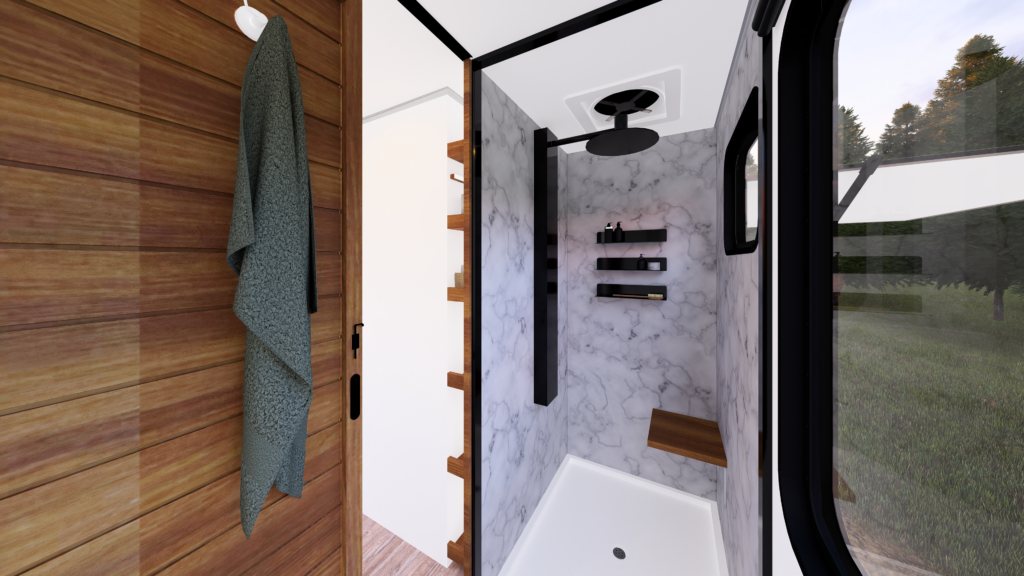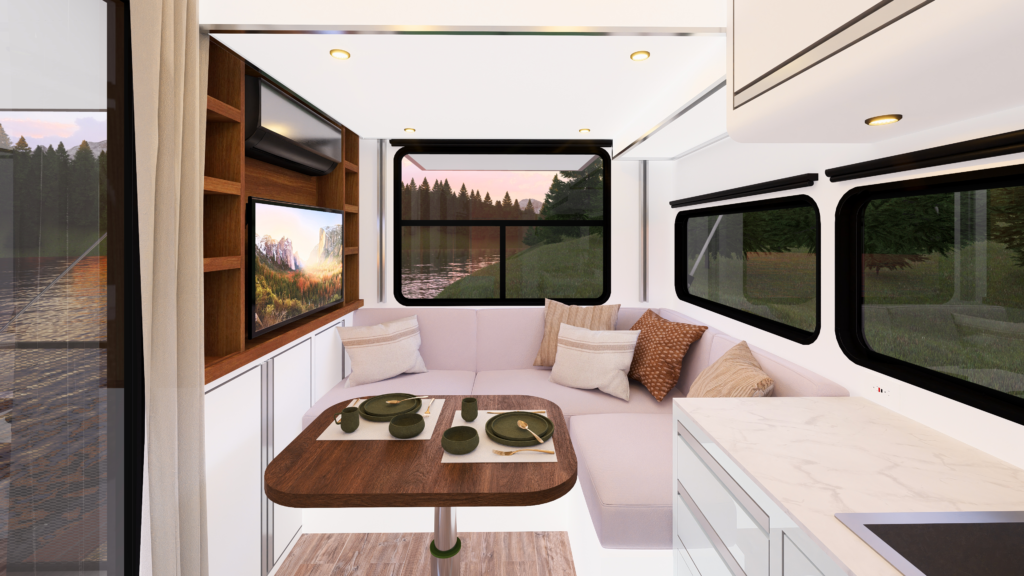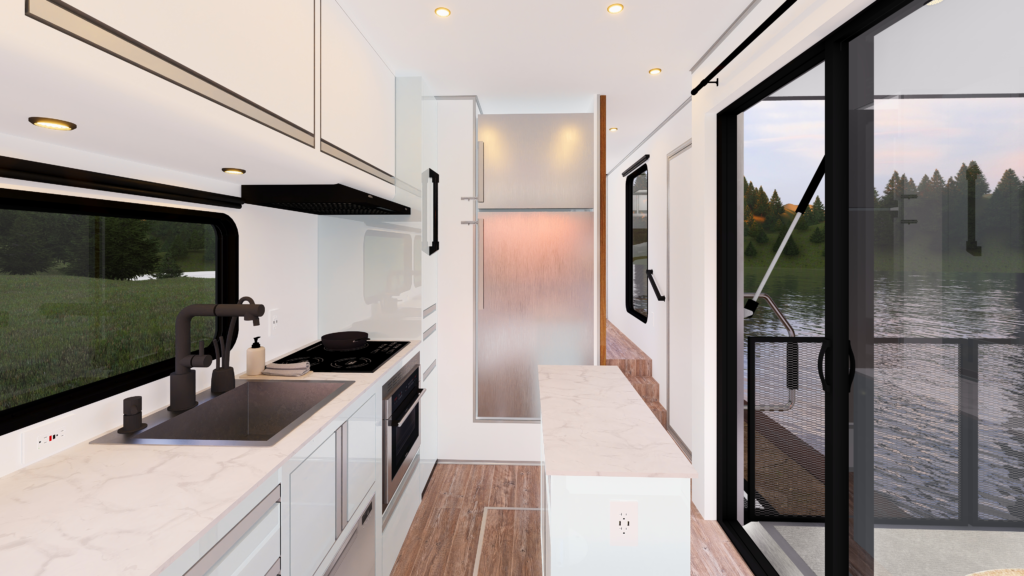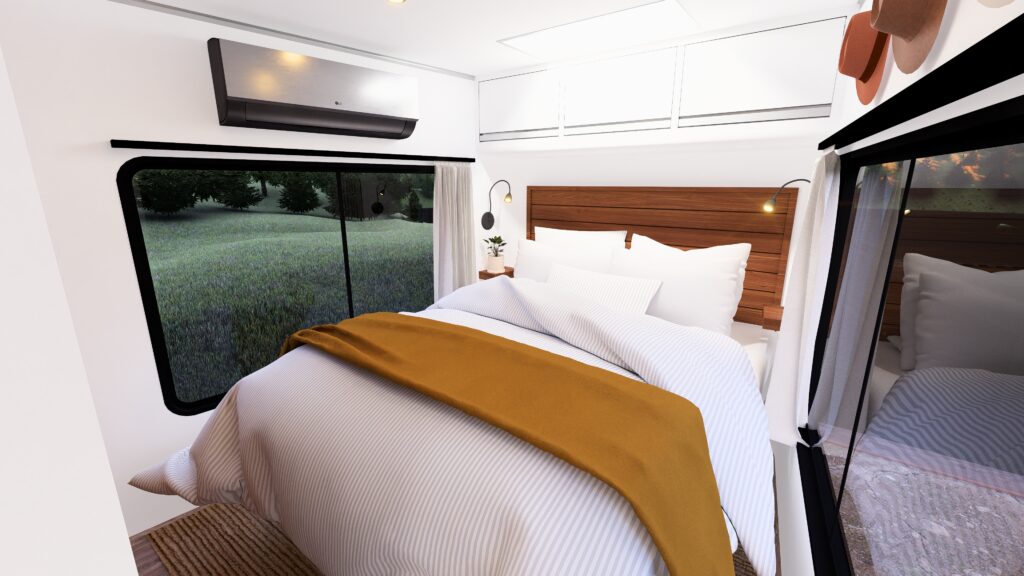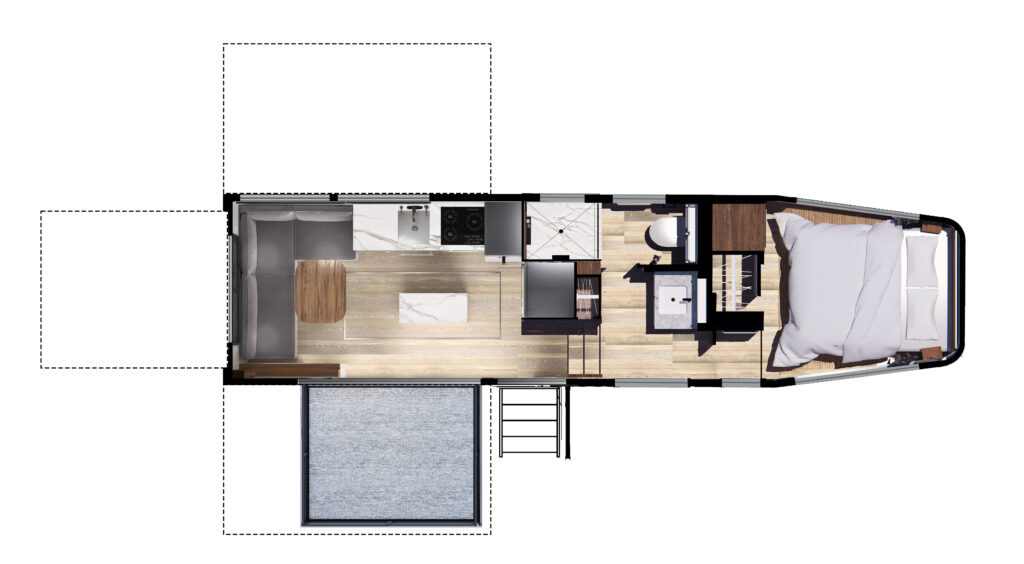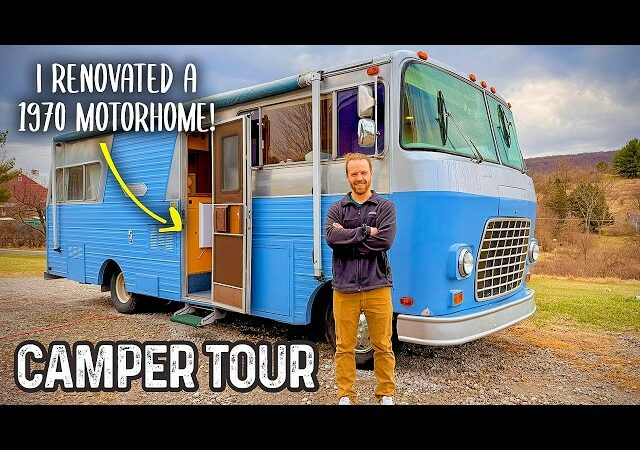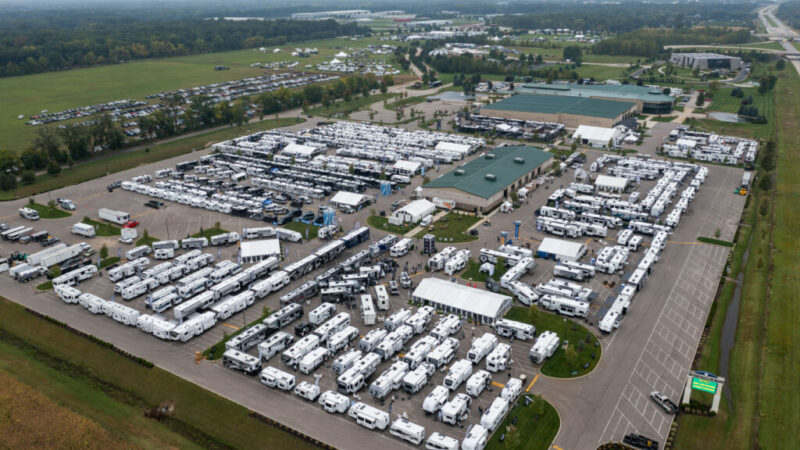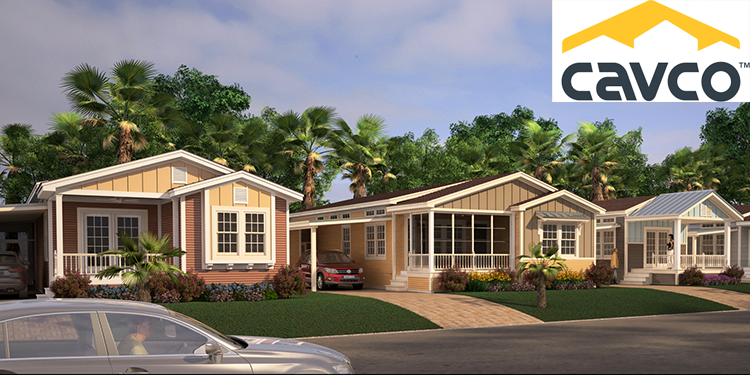Living Vehicle Showcases its All-Electric Lineup for 2026 – RVBusiness – Breaking RV Industry News
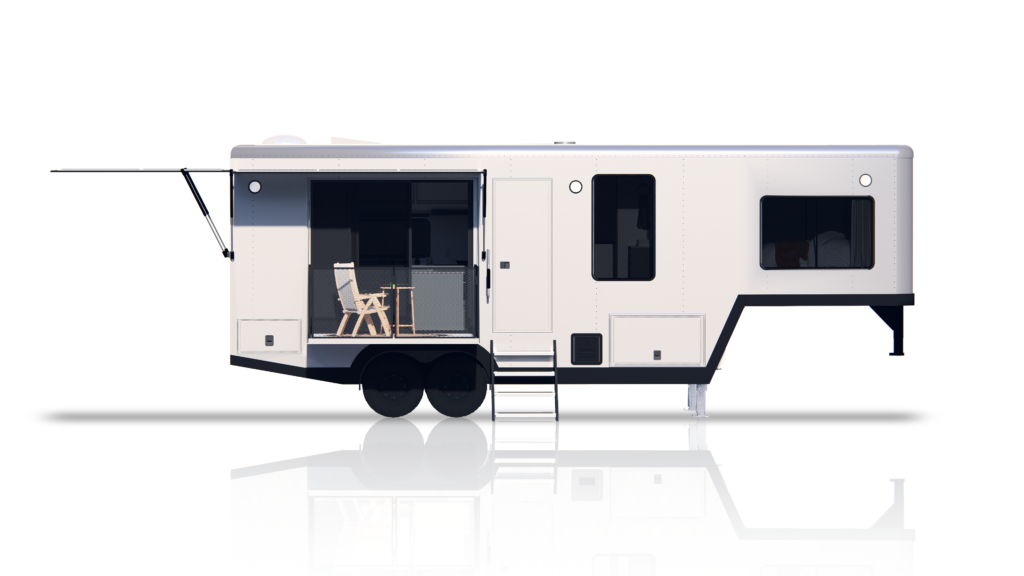
When purchasing a Living Vehicle all-electric home on wheels, the customer becomes part of that outdoor-enthusiast family. “We are dedicated to prioritizing the experience of our owners above all else,” said Founder & CEO Matthew Hofmann. Hofmann said that the company provides personalized customer service, and the minute a new owner tows a Living Vehicle off the lot — or uses LV’s direct-to-home delivery service — the company’s cofounder Walter Hofmann, aka Wally, steps in to be a personal concierge.
Living Vehicle, started in 2017 by Matthew and Wally, “share a vision of redefining freedom through design.” The father-and-son duo, with many years of architecture, engineering and business experience, have succeeded in creating self-sufficient travel trailers and fifth-wheels that keep folks off the grid without sacrificing creature comforts. Scratch that—LV goes beyond “creature comforts;” these trailers are for “living in luxury.” While most manufacturers are focused on self-containment for short-term use, LV’s whole approach is to be able to operate without plugging in and maintaining resources. New for the 2026 model year is the ability for customers to custom-tailor their own Living Vehicle.
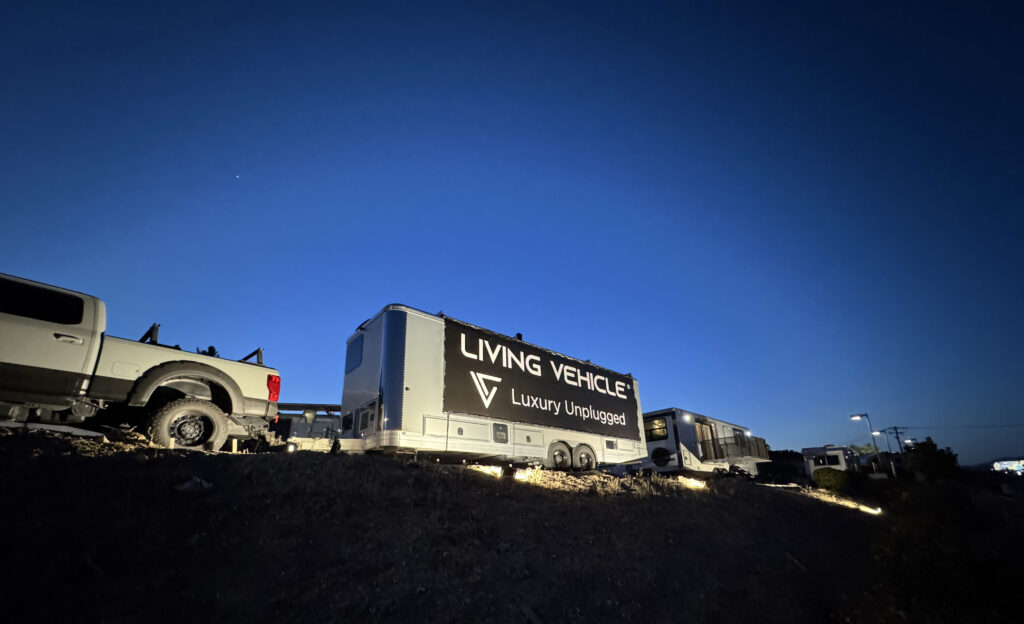
Living Trailers versus Travel Trailers
The company classifies its trailers into two distinct categories: The robust HD and GT lines are mobile residences with dedicated bedrooms and are designed to be lived in full time or for extended stays, so they are categorized as “Living Trailers.” One of these “Living Trailers” would make a captivating guest house, especially if you’ve got property with a view and on-site utilities. Customers will need an appropriate tow vehicle to move an HD or GT since they weigh in at 12,000-plus pounds. The CyberTrailer, which is due out later this year with production ramping up in 2026, is what the company categorizes as its “Travel Trailer” since it’s designed to be far more mobile. Its luxurious and adaptable one-room interior with six configurations can be altered to fit the owner’s needs, with a bathroom suite on one side of the trailer. The CyberTrailer is being purpose-built to be towed by half-ton trucks, including electric pickups like the Cybertruck, Ford F-150 Lightning and Rivian R1T.
Now that we’ve made the distinction, Living Vehicle’s line consists of the HD24 and HD30, which are traditional travel trailers; the GT32 and GT39 fifth-wheels; and the 27-foot CyberTrailer travel trailer. And there are no convoluted nomenclatures here—the numbers refer to the true lengths of the trailers as measured from front wall to rear wall.

Complete Refresh for 2026
From the beginning, Living Vehicle’s motto has been “Luxury Unplugged.” For the 2026 model line, available now, the focus has been on a complete refresh by incorporating integrated tech when it comes to being able to connect to the internet and staying connected, and pushing the envelope to see how long a customer can really stay off-grid. “Now that our legacy brand’s quality has been established, we went from ‘bigger is better’ thinking to making things a lot more efficient,” said Hofmann. “Maximizing off-grid time and the efficiencies of resource generation is really the core tenet of this redesign. We’ve made the systems inside the unit more efficient, producing more resources while you’re off-grid so you can embody that motto of luxury unplugged as much as possible.”
The updates include “more efficient fixtures, and the power consumption inside the unit has been drastically reduced to extend that off-grid time,” said Hofmann. “The line we’re really walking is how much can you create—whether it’s water or power off-grid.” Living Vehicle’s water-generation system is now on version 3 and “in a major upgrade on our march toward self-sufficiency our water-generation system is capable of producing up to 13 gallons a day.”
Hofmann explained that the water-generation system essentially draws air in, moves it across a condenser, and then pulls water from the air through heat extraction. It then fills up a water reservoir and pumps it through a multistage filtration process. Said Hofmann, “It actually remineralizes the water to fill up your freshwater tank.” And since the system is integrated, a touch panel on the RV’s control system “allows you to see in real-time the water you’re generating. And then based upon the humidity, you can see how much power you’re using.”
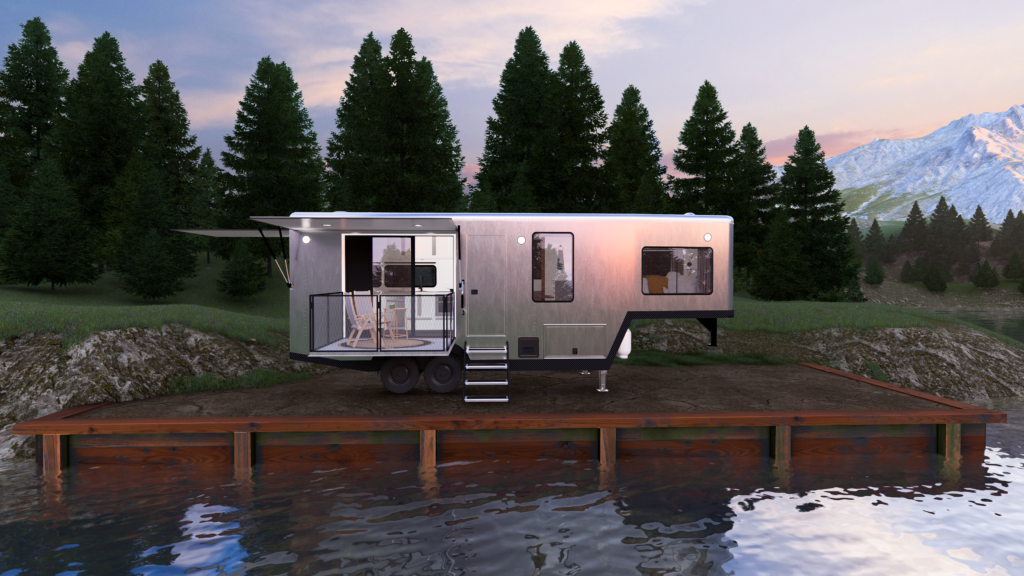
Regal & Rugged
Inside an 8½-foot-wide “Living Trailer” you’ll find luxurious amenities like a state-of-the-art kitchen with residential-height solid-surface countertops, a residential fridge, ample storage, a spa-like bathroom, a spacious and bright bedroom, and a whisper-quiet air conditioner thanks to the European-style mini-split unit that is built into the chassis. Options include a drawer dishwasher, black-walnut paneling and wood treatments in the bathroom, a composting toilet and a host of other things to personalize your Living Vehicle.
The exterior is anodized aluminum, and Living Vehicles are built on an aluminum chassis with a custom tongue-and-groove aluminum decking integrated into the chassis. “They’re built like a tank,” said Hofmann. A major feature of every Living Vehicle is the curbside fold-down patio, rated for 1,500 pounds, that keeps the user more than 3 feet off the ground. Collapsible railings can be set up within minutes—valuable for keep a pet from jumping overboard if spotting a critter. The patio is accessed through an 8-foot sliding door off of the kitchen, creating a seamless transition to the outdoors.
Living Vehicles are four-season capable, with temperature ratings based upon trim levels—anywhere from minus 4 degrees to 120 degrees F. These trailers can even power an electric car.
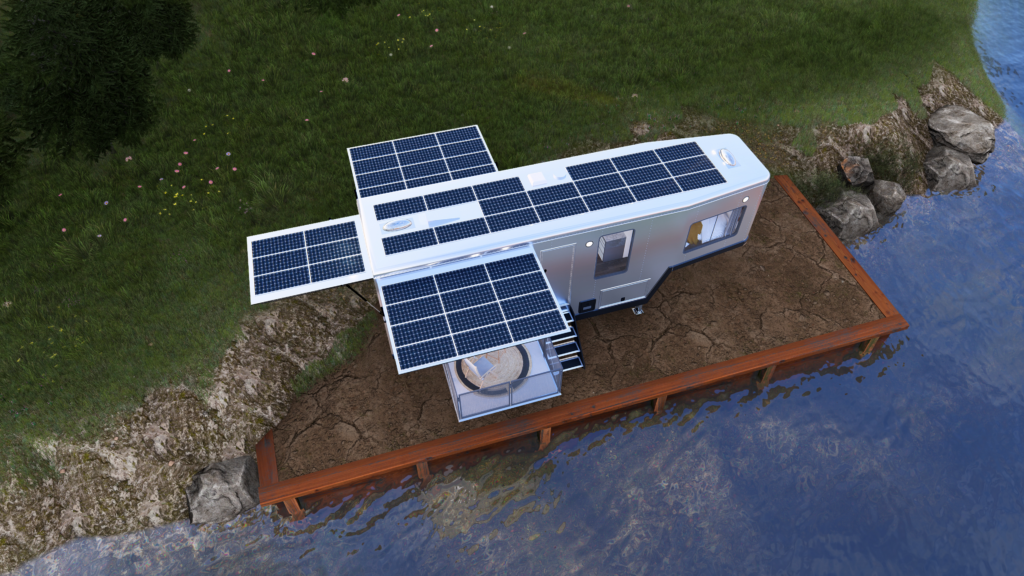
Unlimited Solar
Depending on the configuration, a Living Vehicle can be outfitted with up to 5,800 watts of solar power, like on the GT39. Additionally, the company offers deployable solar. “Basically, you can have unlimited solar,” said Hofmann. “With this larger platform you can connect into an on-site solar array. For example, if you’ve got land and don’t have the ability to put in a 50-amp shorepower panel, you can create an off-grid living environment that is completely independent and powers the energy system on the unit. This is what we’ve actually designed the GT series for—this is our full-time living or extended-living product.”
Not only are the rooftops of a Living Vehicle lined with solar panels, but depending on the trim level you opt for, the trailer can be equipped with “butterfly” awnings—solar awnings that wing upward from the sides, providing shade over the curbside patio. These awnings are hinged at the top and lock against the side of the trailer during travel.
The GT fifth-wheel models have the option of a deployable solar awning at the rear of the trailer as well to maximize solar gain. Explained Hofmann, “The flagship GT39 is built like a yacht, while the GT32 is a more nimble, user-friendly trailer that maintains all the functionality of its larger sibling. We have a whole new package of imagery for the GT32 and we’re very excited about this unit. There’s also a 3D tour of it on the website.”
The new GT32’s base weight is 13,250 pounds and it has a 16-inch ground clearance. It can sleep four with the bedroom’s king-size bed and the living area’s convertible lounge. The kitchen’s island is actually removable so it can be moved to the patio for outside use or to make some extra space inside.
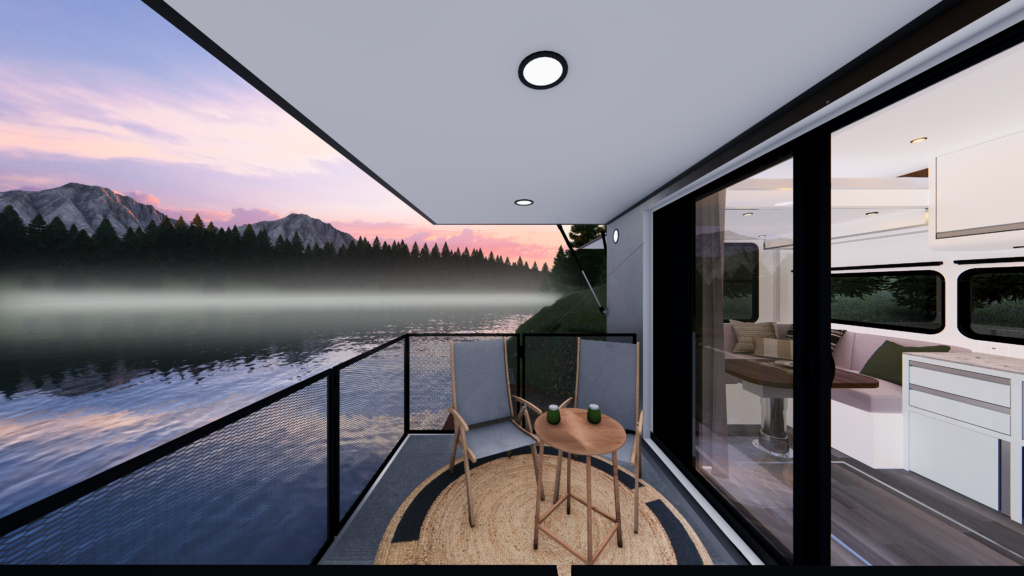
Trim Levels and Custom Configurations
LV’s lineup consists of four trim levels: ECO, COR, MAX and PRO. The ECO is designed for on-grid and is the standard foundation for all configurations. The ECO can also be outfitted with all options and travel as any other RV, requiring full hookups at campgrounds.
The COR, MAX and PRO are LV’s off-grid models. As trim levels increase, so does solar capacity, energy storage, inverter power and temperature ratings. The Level 2 EV Charging Package adds more power for e-bikes and toys.
New for the 2026 model year is that the entire Living Vehicle line is available with a custom configuration so customers can design their own trailer from the ground up, “becoming the architect of their mobile sanctuary.” Every design starts with a blank canvas, and from there the customer determines what they want from dozens of custom packages and options. With this flexible manufacturing system in place, a consumer can start with a lower entry price and design a trailer for on-grid or off-grid use.
Hofmann said that a full-feature configurator will be released on the website in the coming weeks for customers to self-configure their units and generate a custom quote in real time.
Fresh Off the Lot
Earlier this year, Living Vehicle opened a dealership in the Greater Los Angeles area so now people have easy access to check out various new and preowned units. Customers are welcome to come by during business hours of 8 a.m. to 5 p.m. Monday–Friday and by appointment on the weekends. Hofmann encourages making an appointment to be guaranteed a personalized tour by him or Wally as they love to show off their trailers! Notices of their availability are posted on social media, and you can stay up to date on Living Vehicle’s happenings on social by subscribing. The dealership is located at 31280 The Old Road in Castaic, California. Said Hofmann, “It’s quite a sight to see 10 Living Vehicles all lined up!”
The company offers nationwide open-source service across the United States and Canada, plus mobile service providers who will come to the customer. LV handles everything after a customer’s direct call to them. Living Vehicle recently partnered with a lender in California to offer financing on new units as well as inventory. Prior to now, a new order required cash up front to produce a custom build. livingvehicle.com
